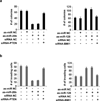Functional screen analysis reveals miR-26b and miR-128 as central regulators of pituitary somatomammotrophic tumor growth through activation of the PTEN-AKT pathway
- PMID: 22614013
- PMCID: PMC4034118
- DOI: 10.1038/onc.2012.190
Functional screen analysis reveals miR-26b and miR-128 as central regulators of pituitary somatomammotrophic tumor growth through activation of the PTEN-AKT pathway
Abstract
MicroRNAs (miRNAs) have been involved in the pathogenesis of different types of cancer; however, their function in pituitary tumorigenesis remains poorly understood. Cyclic-AMP-dependent protein kinase-defective pituitaries occasionally form aggressive growth-hormone (GH)-producing pituitary tumors in the background of hyperplasia caused by haploinsufficiency of the protein kinase's main regulatory subunit, PRKAR1A. The molecular basis for this development remains unknown. We have identified a 17-miRNA signature of pituitary tumors formed in the background of hyperplasia (caused in half of the cases by PRKAR1A-mutations). We selected two miRNAs on the basis of their functional screen analysis: inhibition of miR-26b expression and upregulation of miR-128 suppressed the colony formation ability and invasiveness of pituitary tumor cells. Furthermore, we identified that miR-26b and miR-128 affected pituitary tumor cell behavior through regulation of their direct targets, PTEN and BMI1, respectively. In addition, we found that miR-128 through BMI1 direct binding on the PTEN promoter affected PTEN expression levels and AKT activity in the pituitary tumor cells. Our in vivo data revealed that inhibition of miR-26b and overexpression of miR-128 could suppress pituitary GH3 tumor growth in xenografts. Taken together, we have identified a miRNA signature for GH-producing pituitary tumors and found that miR-26b and miR-128 regulate the activity of the PTEN-AKT pathway in these tumors. This is the first suggestion of the possible involvement of miRNAs regulating the PTEN-AKT pathway in GH-producing pituitary tumor formation in the context of hyperplasia or due to germline PRKAR1A defects. MiR-26b suppression and miR-128 upregulation could have therapeutic potential in GH-producing pituitary tumor patients.
Figures






Similar articles
-
Lineage-dependent role of miR-410-3p as oncomiR in gonadotroph and corticotroph pituitary adenomas or tumor suppressor miR in somatotroph adenomas via MAPK, PTEN/AKT, and STAT3 signaling pathways.Endocrine. 2019 Sep;65(3):646-655. doi: 10.1007/s12020-019-01960-7. Epub 2019 Jun 4. Endocrine. 2019. PMID: 31165412 Free PMC article.
-
Altered microRNA expression profile in human pituitary GH adenomas: down-regulation of miRNA targeting HMGA1, HMGA2, and E2F1.J Clin Endocrinol Metab. 2012 Jul;97(7):E1128-38. doi: 10.1210/jc.2011-3482. Epub 2012 May 7. J Clin Endocrinol Metab. 2012. PMID: 22564666
-
MicroRNA-200c inhibits apoptosis in pituitary adenoma cells by targeting the PTEN/Akt signaling pathway.Oncol Res. 2013;21(3):129-36. doi: 10.3727/096504013X13832473329999. Oncol Res. 2013. PMID: 24512727
-
Effect of miR-106b on Invasiveness of Pituitary Adenoma via PTEN-PI3K/AKT.Med Sci Monit. 2017 Mar 13;23:1277-1285. doi: 10.12659/msm.900092. Med Sci Monit. 2017. PMID: 28288092 Free PMC article.
-
PRKAR1A and the evolution of pituitary tumors.Mol Cell Endocrinol. 2010 Sep 15;326(1-2):3-7. doi: 10.1016/j.mce.2010.04.027. Epub 2010 May 6. Mol Cell Endocrinol. 2010. PMID: 20451576 Free PMC article. Review.
Cited by
-
BMI1: A Biomarker of Hematologic Malignancies.Biomark Cancer. 2016 May 5;8:65-75. doi: 10.4137/BIC.S33376. eCollection 2016. Biomark Cancer. 2016. PMID: 27168727 Free PMC article. Review.
-
microRNA expression and biogenesis in cellular response to ionizing radiation.DNA Cell Biol. 2014 Oct;33(10):667-79. doi: 10.1089/dna.2014.2401. Epub 2014 Jun 6. DNA Cell Biol. 2014. PMID: 24905898 Free PMC article. Review.
-
Differentially Expressed MicroRNAs in Meningiomas Grades I and II Suggest Shared Biomarkers with Malignant Tumors.Cancers (Basel). 2016 Mar 3;8(3):31. doi: 10.3390/cancers8030031. Cancers (Basel). 2016. PMID: 26950155 Free PMC article.
-
GH and IGF System: The Regulatory Role of miRNAs and lncRNAs in Cancer.Front Endocrinol (Lausanne). 2021 Aug 16;12:701246. doi: 10.3389/fendo.2021.701246. eCollection 2021. Front Endocrinol (Lausanne). 2021. PMID: 34484116 Free PMC article. Review.
-
Deregulation of miR-183 and KIAA0101 in Aggressive and Malignant Pituitary Tumors.Front Med (Lausanne). 2015 Aug 10;2:54. doi: 10.3389/fmed.2015.00054. eCollection 2015. Front Med (Lausanne). 2015. PMID: 26322309 Free PMC article.
References
-
- Bartel DP. MicroRNAs: Genomics,biogenesis,mechanism and function. Cell. 2004;116:281–297. - PubMed
-
- Croce CM, Calin GA. MicroRNAs, cancer and stem cell division. Cell. 2005;122:6–7. - PubMed
-
- Takamizawa J, Konishi H, Yanagisawa K, Tomida S, Osada H, Endoh H, et al. Reduced expression of the let-7 microRNAs in human lung cancers in association with shortened postoperative survival. Cancer Res. 2004;64:3753–3756. - PubMed
-
- Iorio MV, Ferracin M, Liu CG, Veronese A, Spizzo R, Sabbioni S, et al. MicroRNA gene expression deregulation in human breast cancer. Cancer Res. 2005;65:7065–7070. - PubMed
-
- Bandres E, Bitarte N, Arias F, Agorreta J, Fortes P, Agirre X, et al. macrophage migration inhibitory factor production and proliferation of gastrointestinal cancer cells. Clin Cancer Res. 2009;15:2281–2290. - PubMed
Publication types
MeSH terms
Substances
Grants and funding
LinkOut - more resources
Full Text Sources
Other Literature Sources
Research Materials

